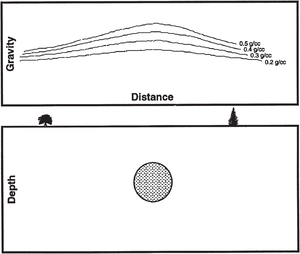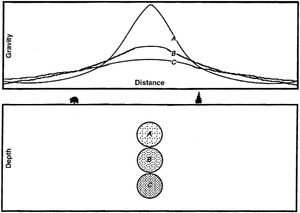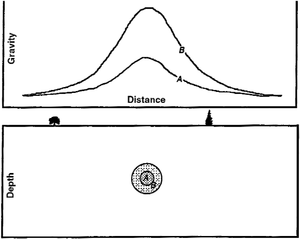Gravity anomaly models
| Exploring for Oil and Gas Traps | |

| |
| Series | Treatise in Petroleum Geology |
|---|---|
| Part | Predicting the occurrence of oil and gas traps |
| Chapter | Applying gravity in petroleum exploration |
| Author | David A. Chapin, Mark E. Ander |
| Link | Web page |
| Store | AAPG Store |
Three key parameters of the source body affect the size and shape of the gravity response:
- Density
- Depth
- Size
In the following discussion, 2-D cross sections demonstrate each of these parameters on theoretical gravity profiles. While the models may not be geologically reasonable, the concepts they demonstrate provide important building blocks for more complex geometric modeling, which is often performed to solve real exploration problems. When modeling gravity effects, it is much more important to constrain the size (shape) and depth of the geologic body than it is to constrain the density.
Effect of density
The amplitude of a gravity anomaly has a linear relationship to density. Positive density contrasts produce gravity highs; negative density contrasts produce gravity lows. The wavelength of the anomaly is unaffected by differences in the density. Figure 1 shows the different gravity responses to a body with different positive density contrasts. In the upper half of the diagram are the gravity responses. The lower half of the diagram is a cross section. Values for the different densities are written next to the gravity response in the upper part of the figure.
Effect of depth
The amplitude of the gravity signal varies as a function of 1/depth2 to the source. Figure 2 shows the gravity responses to a body of positive density contrast buried at different depths. The upper half of the diagram shows the gravity responses (labeled A, B, and C) to a body buried to depths A, B, and C, shown in the cross section in the lower half.
Effect of size
The gravity response is related directly to the amount of anomalous mass. Size differences in three dimensions are X3 functions. Figure 3 shows the gravity responses to bodies of the same density, at approximately the same depth, that are of different sizes.
See also
- Gravity basics
- Processing gravity data
- Interpreting gravity measurements
- Examples of gravity applications


